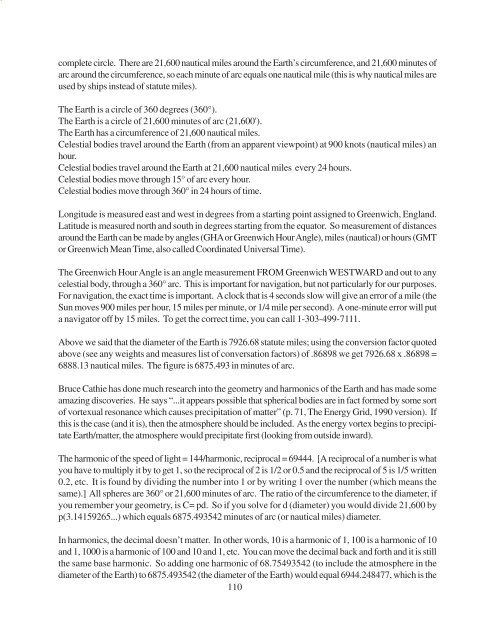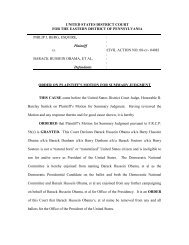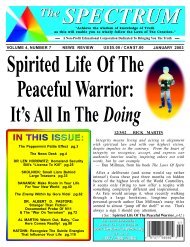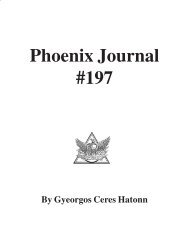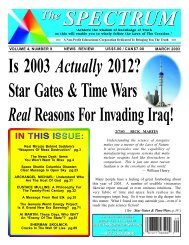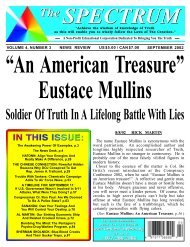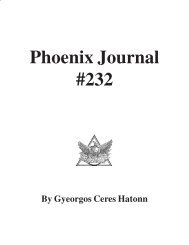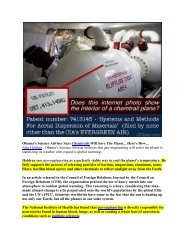Phoenix Journal 208 - Four Winds 10
Phoenix Journal 208 - Four Winds 10
Phoenix Journal 208 - Four Winds 10
You also want an ePaper? Increase the reach of your titles
YUMPU automatically turns print PDFs into web optimized ePapers that Google loves.
complete circle. There are 21,600 nautical miles around the Earth’s circumference, and 21,600 minutes of<br />
arc around the circumference, so each minute of arc equals one nautical mile (this is why nautical miles are<br />
used by ships instead of statute miles).<br />
The Earth is a circle of 360 degrees (360°).<br />
The Earth is a circle of 21,600 minutes of arc (21,600').<br />
The Earth has a circumference of 21,600 nautical miles.<br />
Celestial bodies travel around the Earth (from an apparent viewpoint) at 900 knots (nautical miles) an<br />
hour.<br />
Celestial bodies travel around the Earth at 21,600 nautical miles every 24 hours.<br />
Celestial bodies move through 15° of arc every hour.<br />
Celestial bodies move through 360° in 24 hours of time.<br />
Longitude is measured east and west in degrees from a starting point assigned to Greenwich, England.<br />
Latitude is measured north and south in degrees starting from the equator. So measurement of distances<br />
around the Earth can be made by angles (GHA or Greenwich Hour Angle), miles (nautical) or hours (GMT<br />
or Greenwich Mean Time, also called Coordinated Universal Time).<br />
The Greenwich Hour Angle is an angle measurement FROM Greenwich WESTWARD and out to any<br />
celestial body, through a 360° arc. This is important for navigation, but not particularly for our purposes.<br />
For navigation, the exact time is important. A clock that is 4 seconds slow will give an error of a mile (the<br />
Sun moves 900 miles per hour, 15 miles per minute, or 1/4 mile per second). A one-minute error will put<br />
a navigator off by 15 miles. To get the correct time, you can call 1-303-499-7111.<br />
Above we said that the diameter of the Earth is 7926.68 statute miles; using the conversion factor quoted<br />
above (see any weights and measures list of conversation factors) of .86898 we get 7926.68 x .86898 =<br />
6888.13 nautical miles. The figure is 6875.493 in minutes of arc.<br />
Bruce Cathie has done much research into the geometry and harmonics of the Earth and has made some<br />
amazing discoveries. He says “...it appears possible that spherical bodies are in fact formed by some sort<br />
of vortexual resonance which causes precipitation of matter” (p. 71, The Energy Grid, 1990 version). If<br />
this is the case (and it is), then the atmosphere should be included. As the energy vortex begins to precipitate<br />
Earth/matter, the atmosphere would precipitate first (looking from outside inward).<br />
The harmonic of the speed of light = 144/harmonic, reciprocal = 69444. [A reciprocal of a number is what<br />
you have to multiply it by to get 1, so the reciprocal of 2 is 1/2 or 0.5 and the reciprocal of 5 is 1/5 written<br />
0.2, etc. It is found by dividing the number into 1 or by writing 1 over the number (which means the<br />
same).] All spheres are 360° or 21,600 minutes of arc. The ratio of the circumference to the diameter, if<br />
you remember your geometry, is C= pd. So if you solve for d (diameter) you would divide 21,600 by<br />
p(3.14159265...) which equals 6875.493542 minutes of arc (or nautical miles) diameter.<br />
In harmonics, the decimal doesn’t matter. In other words, <strong>10</strong> is a harmonic of 1, <strong>10</strong>0 is a harmonic of <strong>10</strong><br />
and 1, <strong>10</strong>00 is a harmonic of <strong>10</strong>0 and <strong>10</strong> and 1, etc. You can move the decimal back and forth and it is still<br />
the same base harmonic. So adding one harmonic of 68.75493542 (to include the atmosphere in the<br />
diameter of the Earth) to 6875.493542 (the diameter of the Earth) would equal 6944.248477, which is the<br />
1<strong>10</strong>


